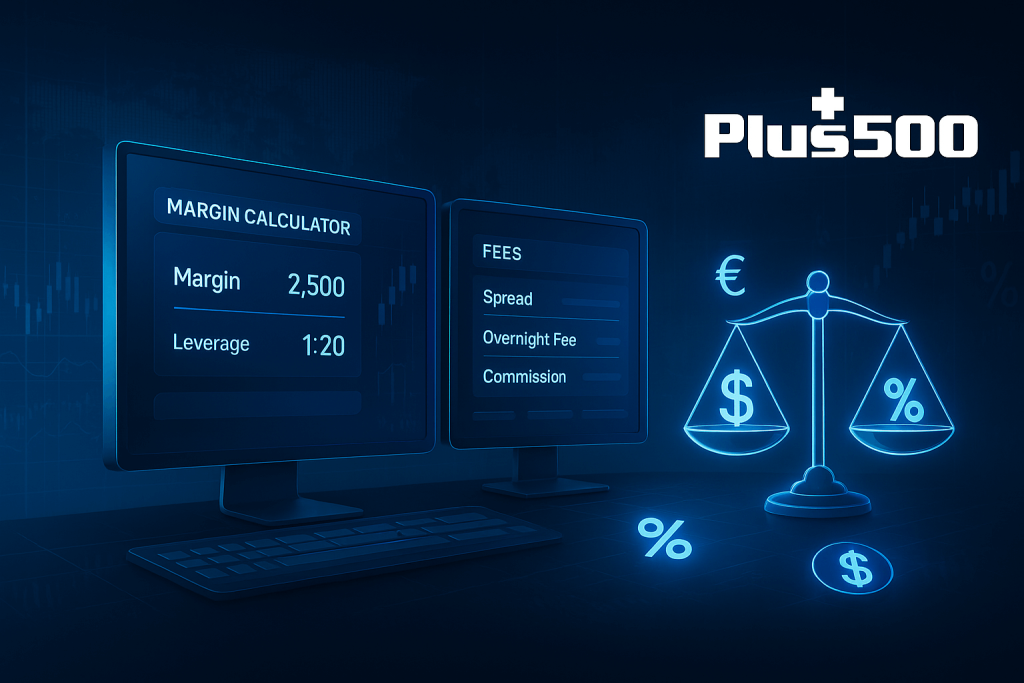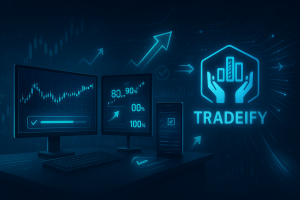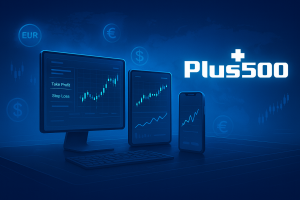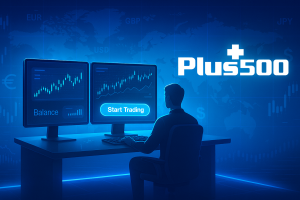In futures trading, profits depend not only on timing and analysis — but also on how well you understand the costs and margin requirements behind every trade. Even small details like spreads, overnight fees, or leverage can significantly affect long-term performance.
For traders using Plus500, mastering these elements is essential. This platform offers competitive pricing and flexible CFD-based futures trading, but to trade efficiently, you must know what each fee means, how margin works, and how to optimize your capital.
What Are Futures CFDs on Plus500?
Futures CFDs (Contracts for Difference) let you speculate on the price movement of a futures contract — such as crude oil, gold, or index futures — without owning the actual contract or commodity.
When trading CFDs on Plus500:
- You trade on price movements, not physical delivery.
- You can go long or short, taking advantage of both rising and falling markets.
- You trade using margin, which allows for leveraged exposure with smaller capital.
For example, trading a Micro E-mini S&P 500 CFD means you only need a fraction of the full contract value to participate in market moves worth thousands of dollars. This leverage amplifies both profit potential and risk — which makes understanding fees and margins absolutely critical.
Key Fees in Futures Trading on Plus500
Plus500’s pricing model is designed to be transparent and simple. There are no hidden platform or data fees, but each trade includes a few important cost components that every trader should track.
Spread — The Hidden Transaction Cost
The spread is the built-in difference between the buy (ask) and sell (bid) price.
- When you open a trade, you instantly pay this cost.
- The tighter the spread, the lower your effective entry cost.
- Spread size depends on volatility, time of day, and contract type.
For example, during peak CME trading hours (U.S. morning session), spreads on index futures CFDs are minimal, while during low-volume periods (Asia session), they can widen.
Tip: Always trade during the most liquid hours of the underlying exchange to minimize spread costs.
Commission — Fixed Cost Per Trade
Some Plus500 futures instruments, especially in the U.S., have a fixed commission per side instead of an embedded spread markup.
- Typical range: around $0.50–$0.90 per side per contract.
- That means a complete trade (open + close) costs roughly $1–$1.80 per contract.
This fee is clearly displayed in the order window before execution. For active day traders and scalpers, this transparency allows precise cost planning.
Overnight Funding (Rollover Fee)
When you hold a CFD futures position overnight, you may incur a daily funding adjustment.
- This represents the interest or financing charge for holding leveraged exposure after the trading day ends.
- The rate can be positive or negative depending on whether you’re long or short.
- Overnight costs are displayed in each instrument’s “Details” tab on Plus500.
If you’re primarily an intraday trader, you can avoid this entirely by closing trades before the end of the session.
Currency Conversion Fee
If your trading account and the instrument’s currency don’t match — say, your account is in USD but you’re trading the DAX 40 (EUR) — Plus500 automatically converts profits and losses at a small conversion fee (around 0.7%).
Optimization Tip: Choose instruments denominated in your account’s base currency to avoid this additional cost.
Inactivity and Withdrawal Fees
- Inactivity Fee: A small monthly fee (around $10) applies only if your account remains idle for several months.
- Withdrawal Fee: Plus500 generally does not charge withdrawal fees; however, your payment provider might impose processing charges or exchange rate spreads.
This structure makes Plus500 cost-efficient for both active and occasional traders.
Margin Requirements Explained
Margins are the backbone of futures CFD trading. They define how much capital you need to open and maintain a position, and they directly influence leverage.
Initial Margin (Opening Requirement)
The initial margin is the minimum deposit required to open a trade.
For instance, if a Micro E-mini S&P 500 CFD requires a $100 margin per contract, that’s the amount you must have available to enter the position.
Since you control the entire notional value of the contract, this gives you leverage — sometimes as high as 1:100, depending on the instrument and regulation.
Maintenance Margin (Sustainability Requirement)
Once your trade is active, you must maintain a certain balance to keep it open.
If your account equity drops below the maintenance margin threshold, Plus500 will automatically close your positions to protect you from a negative balance.
Example: If your trade uses $100 margin and your maintenance margin is 50%, Plus500 will close the trade if your account equity falls below $50 for that position.
Intraday vs. Overnight Margin
Plus500 distinguishes between two main margin types based on trade duration:
- Intraday Margin: Lower margin requirement for trades opened and closed within the same trading day. Ideal for scalpers and day traders.
- Overnight Margin: Higher requirement for trades held past market close. Designed for swing or position traders.
Example:
- Intraday margin for Micro E-mini S&P 500 = about $50 per contract
- Overnight margin = around $2,300 per contract
This distinction encourages intraday traders to manage capital efficiently while ensuring overnight traders have enough buffer for risk exposure.
Margin Monitoring in Real Time
Plus500 displays your live Used Margin, Available Margin, and Equity Balance directly on the trading dashboard.
If your Used Margin approaches 100%, you risk a forced liquidation. Maintaining at least 40–50% free margin ensures smoother execution and protection from margin calls.
Regularly monitor this balance — it’s your real-time health indicator in leveraged trading.
How to Optimize Trading Costs and Margin Efficiency
Even small cost optimizations can compound into significant savings over time. Here’s how to maximize your profitability and minimize unnecessary expenses:
1. Trade During Peak Market Hours
Liquidity is highest when underlying futures exchanges are active. For CME-based contracts (like S&P 500, NASDAQ, crude oil), this is typically 8:30 AM – 4 PM ET. Tighter spreads mean cheaper execution.
2. Use Micro and Mini Contracts
Start small with micro contracts — they require less margin and reduce financial stress. Once you build consistency, scale gradually.
3. Close Positions Before Overnight Cutoff
If you’re trading short-term setups, close before the daily rollover to avoid overnight funding costs and higher margin demands.
4. Match Account Currency to Instruments
Trade instruments that match your account currency (e.g., USD contracts for USD accounts) to bypass conversion fees entirely.
5. Maintain Ample Free Margin
Keep at least 50% of your account balance free at all times. This prevents forced liquidation during sudden volatility.
6. Avoid Overtrading
Every trade has a cost. Focus on high-probability setups rather than volume-based trading, which erodes capital through cumulative spreads and commissions.
7. Check Contract Specifications Regularly
Margins, leverage, and fee structures can change depending on market volatility. Before entering any trade, always verify the current instrument details on Plus500’s platform.
The Role of Leverage in Cost and Risk Management
Leverage allows you to control a large position with relatively small capital — but it cuts both ways.
If you’re using 1:50 leverage, a 2% price move against your position equals a 100% loss of your margin deposit. That’s why disciplined margin control and proper stop-loss usage are essential.
- Use conservative leverage: Experienced traders often risk no more than 1–2% of total equity per trade.
- Plan your exits: Define stop-loss and take-profit levels before entering the trade.
- Track margin utilization: Avoid situations where multiple open trades consume all your available equity.
Remember: leverage is a tool, not a strategy. Its power lies in precision, not in excess.
Key Takeaways
- Spreads and commissions are your primary costs — always check them before entering a trade.
- Overnight funding applies to positions held after market close; intraday traders can easily avoid it.
- Margins determine your risk exposure; understand both initial and maintenance levels.
- Optimizing trading costs involves timing, instrument selection, and disciplined capital management.
- Leverage magnifies both opportunities and risks — use it responsibly.
TradingVPS Integration & Advantage
In the high-speed world of futures and CFD trading, even a fraction of a second can influence your execution price. When latency, connection stability, and platform uptime matter most, a TradingVPS provides the critical infrastructure that keeps you connected to the markets — continuously and securely.
Why a VPS Elevates Your Plus500 Trading
While Plus500 offers fast execution on its own, using a dedicated low-latency VPS ensures your trading platform remains live and responsive 24/7 — even if your home internet or computer fails.
For futures traders who operate during volatile sessions or use high-frequency strategies, this stability can mean tighter fills, fewer disconnects, and improved confidence in every execution.
Optimized Infrastructure for Global Markets
TradingVPS is engineered for professional-level speed and uptime. Our servers are positioned near the world’s most important financial hubs to deliver near-zero latency connections:
- Chicago VPS – optimized for futures trading near CME Aurora data centers, with 0–1 ms latency to major brokers.
- London VPS – perfect for forex traders accessing LD4 liquidity centers.
- New York VPS – built for multi-asset and crypto trading, connected to NY4 and Equinix.
- Frankfurt VPS – designed for forex, crypto, and Solana node operators, located near DE-CIX for lightning-fast routing.
Each VPS is preconfigured on Windows Server 2022 with high-frequency AMD Ryzen 9 7950X CPUs, DDR5 RAM, and NVMe Gen 4 storage — ensuring maximum performance during live market hours.
Always-On Reliability and Security
Every TradingVPS plan includes:
- 99.99% uptime SLA and automated failover
- Dedicated resources (no shared CPU or bandwidth throttling)
- DDoS protection and daily backups
- Multi-monitor support (up to six displays)
- Encrypted remote access from anywhere in the world
Whether you’re day-trading index CFDs, managing multiple forex positions, or monitoring algorithmic systems, your environment remains stable and uninterrupted.
Key Benefits at a Glance
- Sub-1 ms latency to major broker and exchange servers
- Dedicated performance — zero shared resources
- Automated backup and disaster recovery
- Instant provisioning with Windows Server 2022
- 24/7 support from trading-focused engineers
- Global data-center coverage: Chicago, London, New York, Frankfurt
For active Plus500 users trading futures or CFDs across volatile sessions, a TradingVPS is more than a convenience — it’s a competitive edge. Faster connections mean better execution quality, reduced slippage, and uninterrupted strategy performance, all of which directly impact profitability.
Your trading decisions deserve enterprise-level reliability. With a high-performance VPS behind your platform, every tick, chart, and order flow runs at full speed — exactly when precision matters most.




